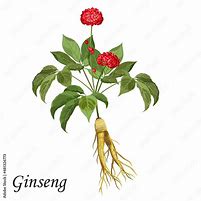Panax Ginseng
THE IMPERIAL PLANT
Dr. Francesco Pensato
The history
Ginseng, in the Chinese language " Jen-Shen " has the meaning of: "Root Man.
The pronounced ideogram Jen is associated to the meaning of man, and shen is associated to the meaning of root.
Also the botanical name Panax Ginseng, reflects hits fame and greatness.
In fact, Panax, from the Greek pan-axos, literally means "that it recovers all ."
An early reference to Ginseng, we can find in the Bible, where in a passage of Ezechiele : They dealt in wheat of Minnith and Pan-nang ( Ginseng ) honey and oil and balm.
Concerning the first meeting between man and ginseng, they are in circulation different legends, but the concensus , is that tha plant had a divine origin .
"The root of ginseng was not found by the man, but he was found by the root."
The first newsworthy report from China is around 3500 B.C. period of the emperor Shen Nung, called the Celestial Grower, in his studies on the grass called "Pen-tshao kan mu", that is' teachings on the understanding of the grass. Emperor Shen Nung's discoveries were taken back and widened by another emperor, Huang Ti, in 2600 B.C.
With the span of centuries, Chinese medicine evolved and Ginseng accompanied this growth.
We find in many quotations about the plant in different documents.
In 200 B.C. the emperor Cho-who-Clu, in one of his writings describes Ginseng as a remedy to recover every sort of illness, reestablishing the normal equilibrium of the organism.
From the seventh, to the tenth century, the dynasty You Ang elected Ginseng to the dignity' of "Imperial Plant."
Around around the year 1000, the dynasty of Sung' declared that its value was equal to its weight in silver.
Seven hundred years after, the emperor K'ang-hsi I sent 10.000 tartars soldiers, to look for ginseng, ordering theirs , that each brought to him not less than two kati (around 1 Kg) of the best quality and he authorized the sale of any surplus with price equivalent to the weight in silver.
Around the eighteenth century Ginseng spreads in the European medical circles, thanks to a Jesuit and to a progressive emperor.
The Emperor had a lot of respect for the erudition of the Jesuits, so submitted ' to Father Jartroux, some topographical papers of central China.
The journey by horse was long and hard through endless central China,
It was' really during a particularly arduous trek, that father Jartoux felt exhausted and deprived of his strengths so much that he could not seat on his horse.
But then , a "miraculous " thing happened !
His guide offered him a piece of a strange root to be chewed and the tiredness disappeared and he was able' to continue the trip with renewed energy.
After that he wrote to the Royal Society in London, describing the effects of this mighty root, called by the tartars "Orhota" that is' “Head of the plants”.
After a few years ginseng was elected, by law, for the first time into an official Pharmacopoeia,
The ginseng has been the most precious plant in the history of far east.
Real wars have been fought for the possession of the forests, in which ginseng spontaneously grew.
A Tartar emperor erected an enormous paling, around a whole province, in defense of his ginseng plantations.
Poachers were punished with death.
In the second half part of the eighteenth century the cultivation of this wild and precious plant, finally took root in Korea perhaps favored by the positive climate.
The botany
The Panax Ginseng belongs to the family of the " Araliacee ".
It is a perennial and deciduous plant, whose leaves dies every autumn and revive in spring.
In the wild state the plant grows in groups propagating itself from the seeds falling from the mother plant.
When it grows naturally the seeds of ginseng buds at the beginning of spring, having remained under earth from 18 to 21 months - a incredibly long germination.
But also the duration of growth is not brief. The first year of bud only grows to 5 centimeters and has three small oval leaves.
In autumn the stem and the leaves fall, leaving a sort of scar on the rhizome of the plant.
The rhizome is a kind of root defined "neck."
Counting the number of scars on the neck of the root ,we are able to count the age' of the plant.
In the third year of growth the plant reaches only around 20 cm tall with only three groups of leaves, each group formed by five leaves (quinquefolium)
By the fourth year it reaches 40 cm , with five groups of leaves.
The fleshy root of ginseng has pale yellow color, with a characteristic bitter taste, and possesses various forms: dragon, child and man -“the most appreciated”.
The root of the Panax ginseng his as edible as carrots or radishes..
In the world exist some varieties of Ginseng classified in a chart from Professor Hara.
In general the most precious variety is " Panax Ginseng C.To. Meyer (jen-Sheng), coming from China.
There are different kind of ginseng .such as Korean Panax Ginseng or Panax pseudoginseng (seven leaves) from Nepal, or from Japan.
Other existing kinds are Panax bipinnafitidum in Thailand and in Myanmar , or the Panax Americano quinquefolium from America.
Properties
As previously explained in the brief history , to this root divine powers has been attributed .
In the light of accurate clinical and toxicological studies we can confirm such voices from the history, affirming that the root of Panax Ginseng contains beneficial properties
In general it is able to restore and to regulate the correct dynamic equilibrium of the human organism, because it increases adaptation to the environmental changes.
Ginseng is the more' effective "natural Adaptogen " existing in the world.
The human organism, through a complicated mechanism of physiological equilibrium, is always in an activity', called "homeostasis" - it maintains a constant environment inside the body.
To understand to best, the concept of "homeostasis" and of " Adaptogen ", we observe what happens in a human body, that is in a situation of danger - defined " fight or flight ", as under threat of an aggressor.
We immediately say that this situation of "stress", following which a series of physiological mechanisms of self-defense are instigated, with the objective to optimize the availability of vital trials.
Cardiac pulsations and blood pressure are increases for bringing more' oxygen to the muscles.
The senses of hearing and of smell will be stronger and the pupils more dilated to pick up more' information.
Breathing becomes faster, using a great quantity' of oxygen .
The blood o capillaries become constrained to reduce perception to pain or bleeding in case of wounds.
Perspiration increases for maintaining under control any heat produced by an intense muscular exercise. Blood is momentarily hijacked from the stomach and the bowel towards the brain.
The Hypothalamus is tied up with hormonal management for the equilibrium of these complex mechanisms.
This happens through the production, from the pituitary gland, of a neurological transmitter hormone, called ACTH.
This hormone orders all the necessary variations, through the targetted stimulation of other organs ,appointed to the production of further hormones.
This self-defense, will finish in the moment at which the situation of danger comes' to pass and all the physiological mechanisms will return to a situation of normalcy.'
Such a mechanism of adaptability' to external conditions, in order to maintain a constant environment inside our organism, is defined "homeostasis."
The factor that is able to favor this physiological return to normalcy is defined as " Adaptogen "
The problems start when the organism doesn't have time or the opportunity to relax, and the mechanisms described before don't stop, rather continue to increase.
This condition we call “negative stress”, as it is able to cause: asthenia, fatigue, attrition, that will be translated in middle to long term into serious health problems.
All the experiments developed for studying the effects and the effectiveness of ginseng, it appears to act on the cerebral bark as a stimulant and also acts on the centers that check the homeostasis, situated in the inferior part or "visceral" of the brain, making the hormonal answer to the external stimuli more’ effective, thanks to its active components: The Ginsenoids .
Ginseng makes the organism' more resistant, reducing consequent damage for every type of battle, both because of pathogenic agents and because of situations of negative stress.
In fact more' then that, ginseng takes care of specific illnesses, restoring a correct “homeostasis “normalizing possible dysfunctions.
In general the main properties of Ginseng are:
1 It increases resistance to the infections and illnesses
2 It improves the general physical conditions of the user and it prolongs life
3 it Improves mental faculties
4 It reduces fatigue and increases vigor
5 it Improve it visual capacity.
Some laboratory tests
Many tests, on the properties of Ginseng, have given amazing results.
One of the first , developed in 1948, in Russia, by the Dr. Brekman, left the experimenter literally without breath.
On a group of one hundred soldiers , was asked to make a run of three km .
An hour before, fifty of them got a spoon of ginseng extract, while to the other fifty got only a spoon of water and flavoring .
All the soldiers that had ingested the extract arrived half a minute before the group that had received only water.
From that first, and encouraging experiment, numerous follow-ups were made all over the world.
A second, very interesting experiment it was' developed by the dr. Medvedev,,in Russia, on a sample of 32 radio-operators ,all from the 21 to 23 years old.
Also in this case the, result was' amazing,
Although the ginseng did not seem to influence the number of transmitted characters, however the number of the errors due to tiredness, notably smaller in the group treated with Ginseng.
Other interesting tests, turned-out to show an effectiveness in the fields of the hypertension and a arteriosclerosis, They had comforting results.
A 56 year-old patient of dr. Popov, had a rate of middle cholesterol of 350 mgs / dl and he had been suffering for years from chronic hypertension resistant to all the medicines.
He was administered extract of ginseng, twice a day, for one month.
At the end of the month his rate of cholesterol was normal.
His blood pressure had also reentered to normal level and surprisingly his mild diabetes had disappeared.
Another clinical test, developed in Korea by Dr. K.H.Koo, showed the effectiveness of the ginseng in the treatment of the hepatitis B, through the normalization of different liver enzymes.
Also in to oppose the aging process, ginseng has shown, in the tests, to have notable effects .
A lot of the existing pathologies in the elderly people can be referred to as a physical and mental deterioration.
In the mechanism of the aging process, role of Free Radicals has strong effect.
These are substances produced by biochemical reactions that happen inside our organism.
Free Radicals have a notable oxidizing power and in contact with cellular molecules they provoke damage and destruction.
In the ginseng there have been isolated components with strong antioxidant, power (phenol and Poly acetylene compounds) to oppose the harmful effects of free radicals and oxidizers
In the final analysis, we can assume that using ginseng only results in positive outcomes.
In fact no tests have ever demonstrated any negative collateral effect on the the human organism.
Dr.Francesco Pensato


